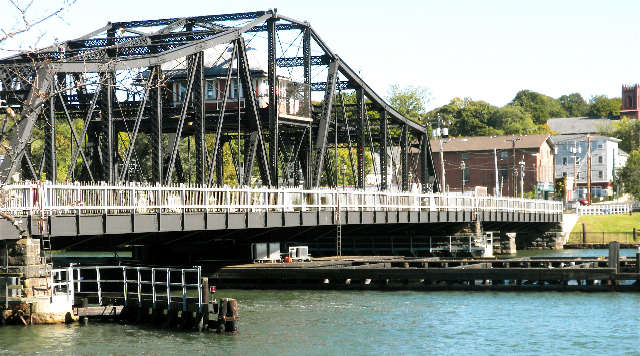
Wikimedia
With evident structural issues and a mechanical system rating of two out of 10, according to City engineers, the Grand Avenue Bridge, a major Elm City bridge located 1.2 miles from Old Campus, is set to undergo major construction.
The bridge, which leads Grand Avenue over the Quinnipiac River, will be renovated over the next one to two years to fix the structure’s mechanical and structural issues. At an informational meeting on Tuesday, city engineers presented about new bridge design and construction plans and sought feedback from the roughly 50 community members in attendance.
“The Grand Avenue Bridge has been one of New Haven’s signature features for generations. It’s beautiful, it provides an important connection between Fair Haven and Fair Haven Heights, and it serves to remind residents of New Haven’s centuries-old maritime heritage,” said New Haven Mayor Toni Harp at the meeting. “This beautiful, useful bridge, however, now needs a great deal of repair work: so much so, it’ll have to be closed for a while to accommodate the workers.”
The Grand Avenue Bridge was built in 1898 and was renovated in 1984, according to City Engineer Giovanni Zinn. The structure is 436-feet long and 34-feet wide.
Harp noted the importance of the fact that the city is undertaking the project “proactively.” Should work be delayed or deferred and have to be done under emergency conditions, she said, “there’s no telling how long it would take.”
“And frankly, if a crisis condition were allowed to occur, the entire bridge could be deemed beyond repair. I don’t have to tell you: Construction of an entirely new bridge is another matter altogether,” Harp added.
$2.5 million of the necessary $25 million to fund the bridge will come from federal, state and local sources, including $1.3 million from the Surface Transportation Program federal funds, $12.5 million from the state local bridge program and up to $7.6 million from local capital funds.
The timeline of the construction is a bid in Spring 2019, a contract award in Summer 2019 and the start of bridge closure in November or December of this year. Construction will go on for one to two years, according to the City’s presentation.
Renovations to be made include steel repairs, new concrete for deteriorating stone, installing a platform to lift bridge and other changes. Additionally, some of the bridge’s machinery — including tapered shafts, motors and brakes — will be replaced. The bridge will undergo electrical changes, including a new control system, new motors and machinery, new traffic control signals and traffic gates and a new navigational control system.
“The bridge is 120 years old and many of its mechanical parts are original equipment,” said City Spokesman Laurence Grotheer. “Mayor Harp and her staff have been working toward this overhaul, convinced it’s better to plan, schedule and complete the work rather than have to do it piecemeal or under emergency circumstances.”
Zinn added in his presentation that it is important to maintain the “historic character” of the bridge.
Grotheer said that the main “swing” span of the current bridge will retain its appearance, but the two fixed approaches to the “swing” span will be replaced. He said that this will improve safety, maintain aesthetics and ensure a viable bridge at that site for future generations of New Haven residents.
The City is also looking at eight different options for a new bright lighting set-up. While there are many questions about possibly lighting the bridge at night, according to the presentation, the bridge’s existing lighting scheme — which has minimal red lights — is an option too. New options include blue lights lining the bridge’s roof and white lights lining the bridge.
Less than a mile away, New Haven’s Pearl Harbor Memorial Bridge — commonly referred to as the Q Bridge — has a LED lighting system that activates at night and recently underwent renovations.
Bridge closures will be required as the city performs structural repairs and replaces mechanical components. However, the city is looking to ensure communication with the public throughout the project, by biweekly email project updates, a web portal for the project, community management teams and communication with alders.
“There’s no denying the inconvenience to area residents, but in exchange, the structure that literally links New Haven to its history will be overhauled, rehabilitated and preserved,” said Harp. “In exchange, this iconic structure will continue connecting generations of New Haven residents, as well as notable New Haven neighborhoods.”
Grotheer said that before the bridge closes, a public awareness campaign will spell out the timing of the closure and publicize alternate routes. Additionally, after the bridge is closed, ample signage and lengthened traffic signal patterns on each side of the river will ease traffic flow along the detour routes, he added.
The City will also look to collaborate with the community throughout construction with a business outreach program and traffic management.
The Local Historic District and Local Historic Properties Commissions in Connecticut called the Grand Avenue Bridge the “central point of the Quinnipiac River Historic District.”
Sammy Westfall | sammy.westfall@yale.edu .
Correction, Feb. 4: The bridge carries Grand Avenue — not the Interstate 95, as previously reported — over the Quinnipiac River.
Interested in getting more news about New Haven? Join our newsletter!







